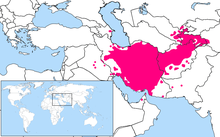Persian dialects and varieties
| Persian | |
|---|---|
| Fārsi | |
| فارسی | |

Fārsi written in Persian (Nastaʿlīq script)
|
|
| Pronunciation | [fɒːɾˈsiː] |
| Native to |
|
|
Native speakers
|
45 million (2007) – 60 million (2009) (110 million total speakers) |
|
Indo-European
|
|
|
Early forms
|
|
|
Standard forms
|
|
| Dialects | |
| Official status | |
|
Official language in
|
|
| Regulated by | |
| Language codes | |
| ISO 639-1 | fa |
| ISO 639-2 |
per (B)fas (T)
|
| ISO 639-3 |
Individual codes: |
| Glottolog | fars1254 |
| Linguasphere |
58-AAC (Wider Persian) |

Areas with significant numbers of Persian speakers (including dialects)
|
|

Countries where Persian is an official language
|
|
Persian (/ˈpɜːrʒən/ or /ˈpɜːrʃən/), also known by its endonym Farsi (فارسی fārsi [fɒːɾˈsiː] (![]() listen)), is one of the Western Iranian languages within the Indo-Iranian branch of the Indo-European language family. It is primarily spoken in Iran, Afghanistan (officially known as Dari since 1958), and Tajikistan (officially known as Tajiki since the Soviet era), and some other regions which historically were Persianate societies and considered part of Greater Iran. It is written in the Persian alphabet, a modified variant of the Arabic script.
listen)), is one of the Western Iranian languages within the Indo-Iranian branch of the Indo-European language family. It is primarily spoken in Iran, Afghanistan (officially known as Dari since 1958), and Tajikistan (officially known as Tajiki since the Soviet era), and some other regions which historically were Persianate societies and considered part of Greater Iran. It is written in the Persian alphabet, a modified variant of the Arabic script.
...
Wikipedia
